|
Clearing the Air
A Scripps researcher hopes to demonstrate that improving developing world cooking methods could slow global warming and improve public health along the way
Robert Monroe | January 25, 2010
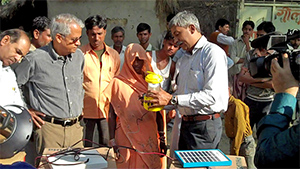
To a village with limited access to electricity, Project Surya co-leaders Veerabhadran Ramanathan (left) and Hafeez Rehman of Indian research institute TERI presented solar-powered lanterns to replace smoky kerosene-burning counterparts.
Smoke rises from a clay stove and blackens the walls of a poorly ventilated kitchen hut somewhere in south Asia. The smoke eventually escapes and adds to a perpetual haze that darkens the horizons over large swaths of poverty-filled regions.
The smoke continues to rise. Its floating soot particles heat the atmosphere as they absorb sunlight and at the same time, they may also cool things at ground level with the dimness they provide. The soot and other forms of black carbon eventually fall back to the ground, having traveled as far as the Himalayas. Onto this bright snow and ice they add a veneer of blackness that hastens melt rates and diminishes glacial stores of drinking water.
The practice of biomass burning — using sticks, grass, or cow dung as free cooking fuel - combines with the production of diesel exhaust from vehicles everywhere to create a large contributor to global warming, possibly second only to carbon dioxide emissions. By accelerating snowmelt, it makes the planet more heat-absorbent as sunlight falls less on the bright ice and snow and more on dark land and water.
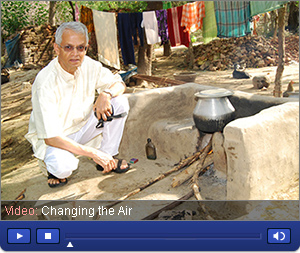
Returning to his grandmother's town of Eraharam, India and a traditional cookstove, Ramanathan says he hopes his grandchild's generation will have a safer way to cook.
This smog, of course, has other unpleasant side effects carbon dioxide doesn't have. The women using crude cookstoves and the children at their feet are first in line to suffer from respiratory problems every time they prepare a meal. Household black carbon emissions have been estimated to cause 2 million or more premature deaths throughout the developing world every year. Even with the smog control efforts in urban areas of the developed world, pollution continues to affect health even in relatively affluent countries.
Veerabhadran Ramanathan, a professor of climate and atmospheric sciences at Scripps Institution of Oceanography at UC San Diego, was one of those children. Spending summers with his grandmother in the village of Eraharam in southern India, he would watch her wheeze through the cooking hour, preparing dishes with a delicious smoky flavor infused at great cost.
Ramanathan grew up to be a scientist who was among the first to understand on a regional and global scale how particulate pollution can simultaneously attenuate and accelerate global warming. His career tracks neatly with the growth of public awareness of climate change and the dangers it poses to the planet. Now his newest project is informed as much by memory as by data.
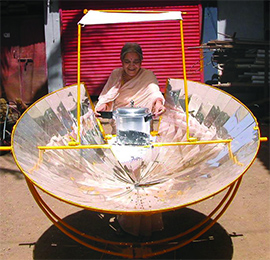
Parabolic disc solar cookers have a free energy source, but present limits in where they can be deployed. Project Surya will test the feasibility of several types of clean-burning stoves.
Project Surya, named for the Sanskrit word for sun, proposes to replace dirty cookstoves with cleaner-burning cookers that operate on wood, gas or even sunlight. Hafeez Rehman, a social scientist from The Energy and Resources Institute (TERI) in India is taking the lead in implementing Surya in the villages. In October, Ramanathan and Rehman oversaw the first deployment of some 30 clean stoves in a village in India's Uttar Pradesh region called Khairatpur. Their goal is to deploy such stoves in more than 5,000 households in the Himalayas and the plains region of northern India and monitor the difference the stoves make in air quality using ground-level measurements made by the residents themselves augmented by data from ground stations and satellite observations capable of house-by-house resolution. Ramanathan expects to see the pollution equivalent of a break in the clouds, a region receiving the full light of the sun and breathing clean air.
"We'll essentially create a black carbon hole and capture that with some of the most sophisticated instruments we have ever deployed," Ramanathan said.
The implications of the small project are enormous and took on special significance in relation to United Nations climate change talks that took place in Copenhagen, Denmark, in December. Even as evidence mounts that carbon dioxide emissions are causing dangerous levels of climate change, countries came to the talks hesitant to agree to emissions cuts. If Surya goes as planned, Ramanathan hopes it can be scaled up to national levels. If that can happen, Ramanathan further hopes that the world can buy itself a few extra decades of protection as countries slowly hammer out emissions policy. Unlike carbon dioxide, which lingers in the atmosphere for more than a century before it breaks down, the lifespan of black carbon particles in the atmosphere is no more than a few weeks.
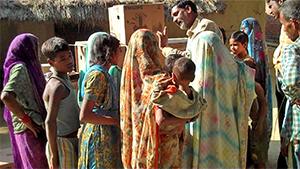
The village chief in Khairatpur, India introduces new cookstoves to residents at the roll-out of the first phase of Project Surya.
"My theoretical calculations suggest removing one ton of black carbon will have the same effect of removing more than 1,000 tons of carbon dioxide in a 50-year time scale," said Ramanathan. "Currently it's our estimate that roughly 3 billion of the world's poor are forced to use biofuel cooking simply because they have no access to fossil fuel."
Ramanathan and colleagues at TERI chose a village called Khairatpur, located some 500 miles south-east of New Delhi, as their first test location. The village is located in the middle of the Indo-Gangetic Plains, a swath of sea-level land straddling the River Ganges where winds circulate freely and 650 million Pakistanis, Indians, and Bangladeshis cram into the most densely populated region in south Asia.
"Surya will undertake the most comprehensive and rigorous scientific evaluation to date on the efficacy of switching to modern biomass-fuel based cooking technologies using state-of-the-art measuring devices," said Rajendra Pachauri, director general of TERI, which is partnering with Scripps on Surya. "Developing countries across the globe are focusing on providing efficient technology options to the underprivileged for meeting their cooking and lighting energy needs. Suitable technology options, while improving access to modern energy, can also contribute to improvement in health while mitigating climate change."
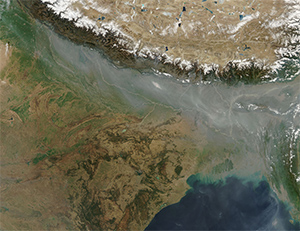
Seen from space, smog collects at the base of the Himalayas before drifting toward the Bay of Bengal. (Photo / NASA)
Ramanathan reports that after an initial demonstration in March 2009, the residents of Khairatpur were eager for the next shipment. The science of Surya will require them to set aside corners of their kitchens for miniaturized air monitoring equipment and perform everyday tasks such as taking photographs of used filters. The village chief has installed an aethalometer, which measures black carbon concentrations as air passes through a filter, on his rooftop.
It took Ramanathan three years of fund-raising and cajoling partners such as Qualcomm (which provides the cell phones that villagers use to call in readings to Surya researchers) and chipping in his own money to get this far. That might have been the easy part. In rural India, as in the rest of the world, society's response to climate change requires a change in mindset and an incremental path of acceptance. Americans are getting used to driving more fuel-efficient cars and installing solar panels on their roofs. In India, the poorest of the poor must accept a form of cooking that is not free. Though black carbon can be washed from the skies nearly overnight, the actions to do that could take much longer.
Jessica Seddon Wallack is Director of the Center for Development Finance at the Institute for Financial Management and Research, in Chennai, India. An economist, she is also a Surya co-investigator. She is tasked with divining what it will take to get people to accept new cookers and what infrastructure changes will need to take place if Surya is to have a chance of catching on. There are many variables. The first few hundred cookers are being provided for free but soon people will have to pay for them, probably by taking out loans. Even the most enthusiastic users of the new stoves, proud to be cooking as the wealthy do, would need access to fuel and spare parts. The kinds of people Ramanathan hopes to reach scarcely have passable roads.
"We're trying to treat it like a marketing problem," said Wallack. "We have to get something that people are willing to pay something for."
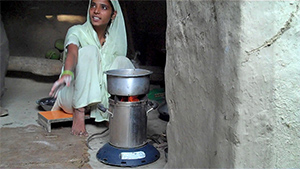
A high-efficiency wood-burning stove supplied by Project Surya is not emission-free but significantly cleaner than homemade stoves used in millions of homes in south Asia.
One component of Wallack's work might eventually be to incorporate the stoves into forms of entertainment that the rural poor are used to and test the effect. The sitcoms and reality shows of the United States have their equal in street theater and soap operas in much of South Asia. Wallack wants to observe the value of product placement in such settings.
The scientists will try several types of cookers — parabolic discs that capture sunlight and allow rapid midday boiling on sunny days, biofuel stoves that will use methane converted from cow dung and stoves that burn wood much more efficiently than the clay stoves. Which one design or combination of designs is deployed more widely will only be decided in later phases of Surya.
"Rural energy has been an internationally neglected area," said Rehman. "There are 600 million people in rural India who are dependent on biomass and biofuel. Surya is drawing the global community and the scientific community on looking at ways to improve their current lot."
After Khairatpur, Ramanathan is attempting to get support that will enable provision of cookers to tens of thousands of households in regions with a variety of atmospheric circulation and solar intensity profiles. He and his co-investigators understand that their pace might need to be slow, but their acceptance is counterbalanced by a feeling of urgency as profound climate changes appear more likely in this century.
"While the challenges are immense, I am optimistic because climate has changed the equation," said Ramanathan. "If we can demonstrate the effect with careful scientific data, we can overcome our hurdles."
This story was originally published in Scripps Explorations Magazine

|